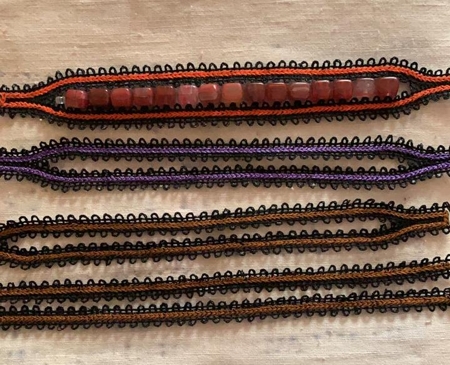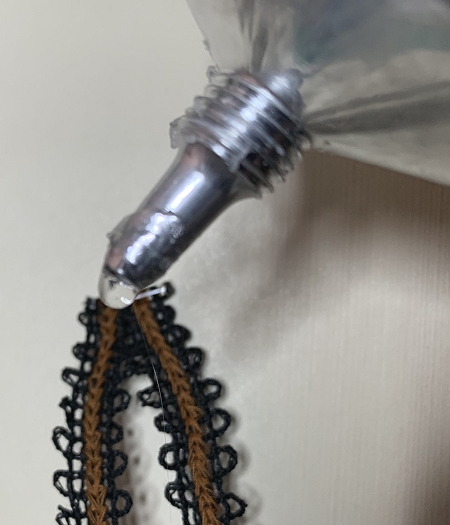These are instructions on how to embroider and assemble the designs from the Freestanding Battenberg Lace Bracelet Set.
There are 3 slightly different designs in the set, which are embroidered in the same way.
|

|
Stitches: 6702
Size: 25mm x 227 mm
Colors: 2
Stitches 6621
Size: 30mm x 217 mm
Colors: 2
Stitches 4906
Size: 24 mm x 169 mm
Colors: 2
|
| Stabilizers: We recommend to use water-soluble mesh, such as Vilene. Vilene D0102 is a non-woven dissolvable stabilizer which is imported into the US, is sold in large rolls and is sometimes packaged under different brand names. Some of these brand names are Fabri-Solvy by Sulky, Avalon Plus by Madeira, Wash-Away, and Aqua Magic. Film-like water soluble stabilizers, such as Solvy by Sulky, Avalon by Madeira and Badge Master are not suitable for Free-Standing Lace embroidery.
|

|
| Threads: The thinner the thread, the finer the final product will be. That is why for this project we recommend machine quilting cotton thread, which gives bulk to the lace and makes it look hand-made. Embroidery polyester thread will make very fine web-like lace.
Embroidery rayon thread is too soft, it does not keep its shape and often its color will fade under the influence of chemicals from the water-soluble mesh.
You can use 40-, 50- or even 60-weight cotton, and you can use it both in the bobbin and in the needle. If you use 40-weight cotton thread for the needle, you shoul use 50- or 60-weight cotton in the bobbin.
We used Signature machine quilting cotton thread both in the needle and in the bobbin, but similar threads from other companies should work just as well.
The drawback of cotton thread is lint. Please don't forget to clean the machine with a soft brush or compressed air after each embroidery.
To get two-sided embroidery, use threads of the same color in the needle and in the bobbin.
|

|
| Needles: We use size 80/12 embroidery needles and 80/12 metallic needles. Our experience shows that cotton thread used with metallic needles gives less lint. The needles should be sharp, so it's advisable to change them often. |
| Most Importantly: ALWAYS make a test stitch-out and wash away the stabilizer. This helps you to select the threads, needles, stabilizers and settings of your machine correctly. It's very important to select the correct thread tension! |

|
| You can read more about how to embroider Battenberg lace in our tutorial. |
|
Washing out the Stabilizer:
|
| Rinsing away the stabilizer is also an important step, because the lace can be stretched or distorted if this is done incorrectly. We recommend to use a foam board and stainless pins. Cut away the excess stabilizer close to the stitches. Take your time and carefully pin every single loop on the lace's outer edge to the board.
Now place the board into a bowl with luke-warm water. Leave the board in the water for at least half an hour. Change the water a couple of times.
Take the board out of the water and leave to air dry. Do not unpin the lace until it's completely dry.
|
|
This stitch-out is used for demonstation purposes only.
|
Making the Bracelets:
|
Besides watersoluble mesh and embroidery threads you will need:
- ribbon ends - 1/2", 5/8", 1" sizes,
- beads 6mm -10 mm (we recommend plastic or polymer clay beads, glass and natural stone beads are usually very heavy),
- seed beads, size 5 and 8,
- bracelet/necklace clasps,
- basic jewelry tools including pliers and cutters,
- craft/fabric glue,
- sewing needle and thread.
|

|
| Step One: Hoop 2 layers of watersoluble mesh. Embroider any of 3 files. |
| Step Two: Cut away the excess stabilizer. Neatly pin the stitch-out to a foam board and rinse the remaining stabilizer. Leave to air dry. Press with steam if needed. |

|
| Step Three: Check the stitch-out on your wrist. |

|
| If it's too long for you, you can trim the ends. |

|
| Apply a drop of glue to prevent unraveling. |

|
| Step Four: Attach the ribbon ends to the ends. |

|
| Using the same thread which which you made the embroidery, sew the beads to opposite loops on the inside of the bracelet. |

|
| For this bracelet, we used 2 stitch-outs: |

|
| Slightly overlap the ends of the stitch-outs. |

|
| Attach the ribbon end. |

|
| Sew on the beads. |

|
| Our beads are 6 mm, we attach them to every other opposite loops. |

|
| If you use seed beads, attach them to every loop. |

|
| Have fun! |
|
Back to Freestanding Battenberg Lace Bracelet Set.
|
|
|
